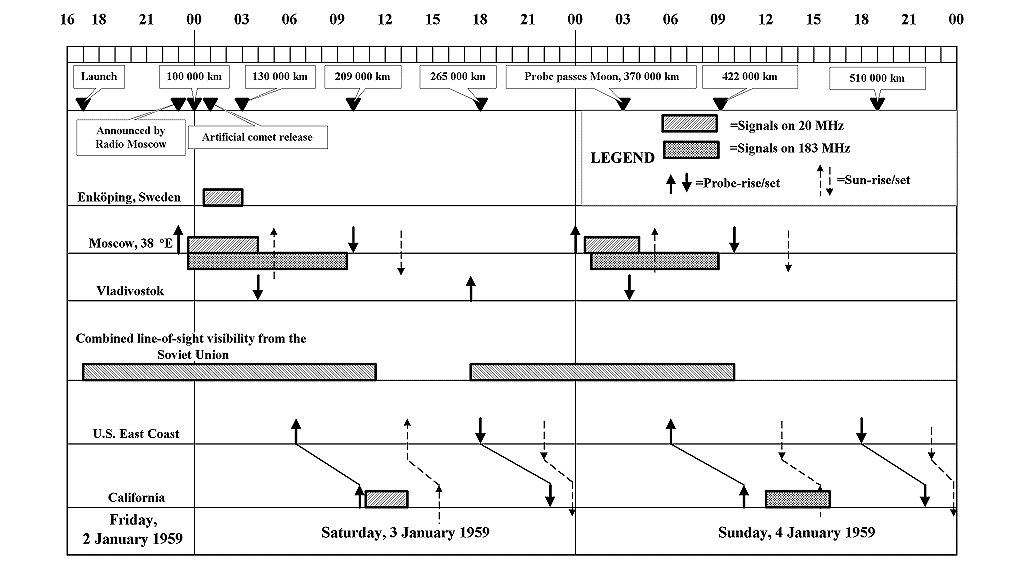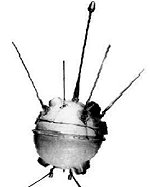
 During
the spring of 1959 stories appeared in US electronics magazines and in
the popular press which claimed that the Soviet Moon probe Luna 1, or Lunik
as it was known then, never existed.
During
the spring of 1959 stories appeared in US electronics magazines and in
the popular press which claimed that the Soviet Moon probe Luna 1, or Lunik
as it was known then, never existed.
The evidence, the stories said, was that there were no confirmed radio receptions in the West of signals from the probe, despite the fact that Radio Moscow announced the transmission frequencies 6 hours after the launch which occurred at 1641 UT on January 2, 1959.
The press stories also pointed out that major installations like the British Jodrell Bank radio observatory failed to pick up the signals. Reports from credible sources, like the Jet Propulsion Laboratory, were discounted with numerous arguments about radio noise from Jupiter, local interference etc. The whole line of reasoning of these press reports were summed up by a reporter, Lloyd Mallan, in his book "The Big Red Lie" (4).
It is now possible to examine
in more detail what caused all this uncertainty. First, one must remember
that all this occurred at the very early stages of space exploration (15
months after Sputnik 1!) and that there was very little experience in receiving
signals from satellites and almost no experience in tracking objects into
deep space. Luna 1 was the first object to pass the Moon.
So, in essence, only two organizations (unclassified, that is), JPL and Jodrell Bank were able to try 183.6 MHz. JPL obviously threw a lot of work into the effort and worked around the clock with skilled personnel to put together a receiving converter. Jodrell was not so successful. Remember, Lunik was launched on a Friday. All the tracking had to be done over the weekend!
JPL tried to receive the probe during the period 1000-2200 UT on January 3, but the very quickly assembled equipment did not work very well. While waiting for the next tracking opportunity the equipment was modified and according to JPL director Pickering the system gain was increased by 40 dB!
The
receiver was located in the antenna structure where the technicians operating
the receiver would call by intercom to the control room (where the dish
was steered) whether or not they had the signal. The control room noted
declination and right ascension (the 85 foot dish had a polar mount). JPL
found that the signal, although weak, was located where the Russians said
it would be. The dispersion in the Dec-RA data was only a few degree in
each axis! The signal was approximately 2 KHz FSK with a 5 Hz keying rate.
It is interesting to note that JPL picked up the signal 8 hours after Lunik
passed the Moon! The distance to the probe must have been more than 450000
km.
Also, as pointed out in (1), it is necessary to have a very low sky noise and background interference from terrestrial stations to track an object outside the ionosphere out to these distances. This requires darkness at the receiver. As demonstrated in (1), the only periods for hearing Lunik on 20 MHz was between "proberise" (approximately equal to "moonrise") and sunrise. As shown in figure 1 this condition lasted only for about 5 hours at middle latitudes.
So, when observers on the US East Coast came into view of the probe at about 0630 UT on January 3, 1959 it was about 170 000 km from Earth! The great distance may have contributed to the failure of stations on the US East Coast to receive the probe on 20 MHz.
The only known report of HF signals received by a US tracking post comes from Stanford University in California (ref 2 p.2). Stanford picked up signals on 19.993 MHz using two-element Yagis steerable in azimuth. One Yagi was horizontally polarized, the other vertically polarized. The azimuth of the signals was determined by peaking the signals by turning the antennas. Signals were picked up during the period 1045-1300 UT on January 3, 1959. This agrees well with "proberise" at about 1000 UT and sunrise at about 1500 UT.
The equipment used in (1) has about 4-5 times more antenna gain that the Stanford setup an it is therefore reasonable that they may have tracked Lunik all the way to the Moon on shortwaves.
So, moderately equipped trackers on HF (like amateurs) had only a 5-hour interval on January 3 to receive the probe. In Europe the launch announcement came near midnight so very few amateurs were alerted. When the probe came into view from the US it was already far away from Earth.
In (2) there is also a report about the reception Hawaii of short-wave FSK signals (frequency shift = 2 kHz) identical to those played by Radio Moscow, i.e. with approximately one frequency shift per second. This signal was reportedly received by a station affiliated with the National Security Agency at 1701 UT on January 2, 1959.
To receive Lunik on shortwaves
with rather unsophisticated equipment probably required that the probe
was close to Earth. A report which seems reliable was in in Swedish newspapers
on January 3. The monitoring station of the Swedish Telecommunications
Administration at Enköping picked up signals in the winter night on
19.993 MHz (same frequency as Stanford) several times during the period
0024-0314 UT on January 3, 1959. It seems that this observation lies within
the "proberise"-to-sunrise period.
In (3) it is reported that the USAF station at Hilo, Hawaii picked up signals on 70.2 MHz 15-20 minutes after launch and that other USAF stations also picked up 70.2 MHz and 212 MHz. These stations were Singapore, Millstone Hill (Mass., USA) and Cape Canaveral.
It is entirely believable
that there were signals on these frequencies and that at least Hawaii got
them. On the last stage of the A-2 (Vostok-type in Soviet parlance) vehicle
there are hairpin shaped antennas very well matching the two frequencies.
It is doubtful if these signals could be heard very far out from Earth
since they were probably rather broadband containing high speed telemetry
from many sensors associated with the propulsion system in the last stage.
Also, the batteries for these transmitters probably went dead quickly.
| Time | Frequency | Location |
|---|---|---|
| January 2, 1959 | ||
| 1701 UT | 20 MHz (approx.) | Hilo, Hawaii (USAF/NASA) |
| 1700 UT | 70.2 MHz | Hilo, Hawaii (USAF/NASA) |
| January 3, 1959 | ||
| 0024-0314 UT | 19.993 MHz | Enköping, Sweden |
| 1045-1300 UT | 19.993 MHz | Stanford Univ. California |
| January 4, 1959 | ||
| 1130-1500 UT | 183.6 MHz | Barstow, California (JPL) |

![]() [Space
Tracking Notes]
[Space
Tracking Notes]
![]()
Copyright © 1996
Sven Grahn